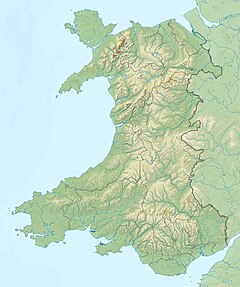Nash Point

Low Tower, Keepers cottages, Fog Horn house and Lighthouse at Nash Point
|
|
|
Wales
|
|
| Location |
St Donats Vale of Glamorgan Wales United Kingdom |
|---|---|
| Coordinates | 51°24′03″N 3°33′08″W / 51.400863°N 3.552259°W |
| Year first constructed | 1832 |
| Automated | 1998 |
| Construction | stone tower |
| Tower shape | tapered cylindrical tower with balcony and lantern |
| Markings / pattern | white tower and lantern |
| Height | 37 metres (121 ft) |
| Focal height | 56 metres (184 ft) |
| Current lens | 360mm catadioptric |
| Intensity | 134,000 candela |
| Range | 21 nautical miles (39 km; 24 mi) |
| Characteristic | Fl (2) WR 15s. |
| Admiralty number | A5406 |
| NGA number | 5816 |
| ARLHS number | WAL-017 |
| Managing agent |
Trinity House |
Trinity House
Nash Point (Welsh: Trwyn yr As) is a headland and beach in the Monknash Coast of the Vale of Glamorgan in south Wales, about a mile from Marcross. It is a popular location for ramblers and hiking along the cliffs to Llantwit Major beach. The lighthouse meadow is a Site of Special Scientific Interest, containing rare plants such as the tuberous thistle, and other wildlife such as choughs can be seen.
Parts of the section of the Glamorgan Heritage Coast where the lighthouse stands consists of "cliffs of Lias limestone interbedded with softer erodible material" and has been identified as potentially at risk from erosion and flooding. Many fossils, including ammonites and gryphaea are to be found there. Marcross Brook passes through the cliffs and an Iron Age hillfort, usually called Nash Point Camp, stands on the north side of the brook, although its remains have been largely eroded by the sea.Round barrows are also to be found nearby. A study of the rocks shows that they exemplify "a 12,000 year old sequence of tufa, scree and slope deposits containing abundant fossil snails", while the Nash Bank offshore is formed by "Jurassic mudstones overlain by bands of sand and gravel". In 1962, the empty tanker BP Driver (formerly the BP Explorer, which had been rebuilt following a disaster in the River Severn) was pushed on the rocks and was abandoned by its crew of five, all of whom survived. Despite the assistance given by the lighthouse, the ship's captain was unable to bring her in safely to land. At low tide, remains of the wreck can be found about 200m north of the beach access by the light house.
...
Wikipedia

